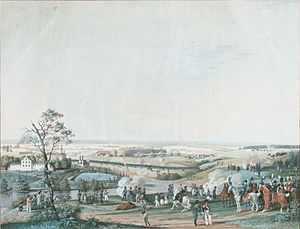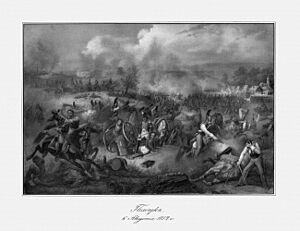First Battle of Polotsk facts for kids
Quick facts for kids First Battle of Polotsk |
|||||||
|---|---|---|---|---|---|---|---|
| Part of the French invasion of Russia | |||||||
 Belarusian Polatsak (Połacak) |
|||||||
|
|||||||
| Belligerents | |||||||
| Commanders and leaders | |||||||
| Strength | |||||||
| 18,000–44,000 men 150 guns |
17,000–20,000 men 98 guns |
||||||
| Casualties and losses | |||||||
| 2,500–6,000 | 1,800–5,500 killed and wounded 1,200–1,500 captured 14 guns |
||||||
The First Battle of Polotsk was a major fight during Napoleon's invasion of Russia in 1812. It happened on August 17–18, 1812, near the city of Polotsk. In this battle, Russian troops, led by General Peter Wittgenstein, faced off against French and Bavarian soldiers. These forces were under the command of General Nicolas Oudinot, and later General Laurent de Gouvion Saint-Cyr. The main goal for the Russians was to stop the French from advancing towards Saint Petersburg, a very important Russian city. This battle is different from the Second Battle of Polotsk, which took place later in the same year.
Contents
Why the Battle Happened
Before this battle, the French forces, led by General Oudinot, had been fighting the Russians. After losing some smaller battles, Oudinot's troops had to pull back to the city of Polotsk. This city became a key point for both armies. The French wanted to push forward, and the Russians wanted to block their path.
The Battle Begins
The fighting started early on August 17. Russian troops, led by General Wittgenstein, attacked the French positions. The French were forced to retreat at first. However, General Oudinot quickly brought in more soldiers and launched a counterattack. By the end of the day, neither side had gained much ground. General Oudinot was injured during the fighting. Because of his injury, command of the French and Bavarian troops was given to General Laurent de Gouvion Saint-Cyr.
Second Day of Fighting
On the morning of August 18, General Saint-Cyr launched a big attack. He cleverly tricked the Russians about where his main attack would be. He moved his troops around and then suddenly attacked the left side and center of the Russian lines. This surprise attack was very successful at first. The French soldiers pushed back the Russians and even captured seven cannons.
It looked like the Russians might lose the battle. But General Wittgenstein quickly organized a counterattack using his cavalry (soldiers on horseback). This unexpected move caused panic among the French troops. They stopped their attack and began to retreat. After this, General Wittgenstein decided to pull his forces back to the Drissa River. Even though his army was smaller, Wittgenstein had successfully stopped two large French armies from reaching Saint Petersburg. This important action later earned him the top general position in the Russian army.
Who Won and What it Cost
The First Battle of Polotsk ended without a clear winner. Both sides held their ground but suffered many losses.
- The French and Bavarian forces lost about 6,000 soldiers, who were either killed or wounded.
- The Russian army lost around 5,500 soldiers, also killed or wounded.
Several important generals were injured or killed in this battle. Among the Bavarians, General Bernhard Erasmus von Deroy was badly wounded and later died. General-Major Siebein was killed. For the French, General Oudinot and General François Valentin were both wounded. Russian Generals Berg, Hamen, and Kazatchkowski also suffered injuries.
What Happened Next
After this intense battle, both armies stayed in their positions for about two months. Neither side tried to start another major fight right away. They were likely recovering from the heavy losses and planning their next moves in the larger war.
More to Explore


